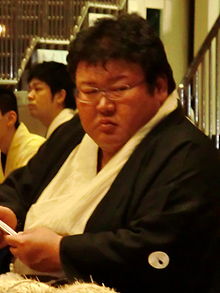- Daishōyama Naoki
-
Daishōyama Naoki Personal information Born Naoki Yamazaki
July 7, 1966
Ishikawa, JapanHeight 1.82 m (5 ft 11 1⁄2 in) Weight 179 kg (390 lb; 28.2 st) Career Heya Tatsunami Record 266-252-40 Debut January, 1989 Highest rank Maegashira 2(January, 1991) Retired November 1995 Yūshō 1 (Juryo)
2 (Makushita)Sanshō Fighting Spirit (1) Kinboshi 3 (Hokutoumi (2), Onokuni * Career information is correct as of March 2009. Daishōyama Naoki (born 7 July 1966 as Naoki Yamazaki) is a former sumo wrestler from Ishikawa Prefecture, Japan. A former amateur champion, he made his professional debut in January 1989 and reached a highest rank of maegashira 2 before retiring in 1995. He is now the head coach of Oitekaze stable.
Contents
Career
Born in Anamizu, Hosu District, as an amateur he won eleven sumo titles, including collegiate and amateur yokozuna, while studying at Nihon University.[1] He also served as captain of the school sumo team. He was recruited by the former sekiwake Annenyama of the Tatsunami stable. Yamazaki had stayed at the heya while taking part in junior high school competitions (as did Daishoho), and he had also met the former Tatsunami stable wrestler Wakanami as an infant, being held in his arms for a photograph (as top rikishi are often requested to do for luck).[1] As an amateur champion he was given makushita tsukedashi status and made his debut in the third highest makushita division. His first tournament was in January 1989 and after two consecutive yusho with perfect 7-0 records in January and March 1990 he was promoted to the second highest juryo division, becoming the first sekitori from Tatsunami stable since the abrupt departure of yokozuna Futahaguro in 1987. He changed his shikona or fighting name from his own surname to Daishoyama at this point.
Daishoyama made his debut in the top makuuchi division in September 1990, and made a kachi-koshi winning score along with three other makuuchi debutants, Akebono, Wakahanada and Takatoriki. This marked the first time that four wrestlers making their top division debuts at the same time had all come through with winning records.[1] In January 1991 he reached what was to be his highest rank of maegashira 2 and earned his first kinboshi for defeating yokozuna Hokutoumi. He was to repeat this upset in July 1991 and also defeated yokozuna Onokuni in that tournament. In January 1993 he had slipped to maegashira 14 in the banzuke rankings but responded with his best ever top division score, winning twelve bouts, defeating Konishiki and Takahanada amongst others and finishing runner-up to Akebono, who was promoted to yokozuna after the tournament. Daishoyama was rewarded with what was to be his only sansho award, for Fighting Spirit.
Daishoyama had had longstanding hip problems since his professional debut,[1] and after missing two tournaments in 1994 through injury he fell back to the juryo division. After being forced to sit out the September 1995 tournament as well he was demoted to the makushita division and retired from sumo in November without competing in any more bouts.
Retirement from sumo
Having fought in 33 sekitori basho Daishoyama was qualified to become a toshiyori, or elder of the Japan Sumo Association, and he purchased the Oitekaze name. In May 1998 he branched out from Tatsunami stable, where he had been working as a coach, and opened up his own Oitekaze stable. His first top division wrestler was Hayateumi in 2000 and he was followed by Hamanishiki in 2001 and the Georgian Kokkai in 2004.
Top division record
Daishoyama Naoki[2]
year in sumo January
Hatsu basho, TokyoMarch
Haru basho, OsakaMay
Natsu basho, TokyoJuly
Nagoya basho, NagoyaSeptember
Aki basho, TokyoNovember
Kyūshū basho, Fukuoka1990 x x x x East Maegashira #12
8–7
West Maegashira #8
9–6
1991 West Maegashira #2
5–10
★West Maegashira #8
8–7
East Maegashira #4
8–7
East Maegashira #2
5–10
★★East Maegashira #9
8–7
East Maegashira #7
9–6
1992 West Maegashira #2
5–10
East Maegashira #8
9–6
East Maegashira #3
6–9
East Maegashira #6
8–7
West Maegashira #2
5–10
West Maegashira #8
5–10
1993 West Maegashira #14
12–3
FEast Maegashira #3
3–12
East Maegashira #12
9–6
East Maegashira #6
5–10
West Maegashira #12
8–7
East Maegashira #10
6–9
1994 East Maegashira #15
9–6
West Maegashira #10
3–11–1
(Juryo) (Juryo) (Juryo) (Juryo) 1995 (Juryo) (Juryo) (Juryo) (Juryo) (Juryo) West Makushita #3
Retired
0–0–7Record given as win-loss-absent Top Division Champion Retired Lower Divisions
Sanshō key: F=Fighting spirit; O=Outstanding performance; T=Technique Also shown: ★=Kinboshi(s) P=Playoff(s)
Makuuchi ranks: Yokozuna — Ōzeki — Sekiwake — Komusubi — Maegashira
Divisions: Makuuchi — Jūryō — Makushita — Sandanme — Jonidan — JonokuchiSee also
- List of past sumo wrestlers
- List of sumo tournament second division winners
References
- ^ a b c d Sharnoff, Lora (1993). Grand Sumo. Weatherhill. pp. 212. ISBN 0-8348-0283-x.
- ^ "Daishoyama Naoki Rikishi Information". Sumo Reference. http://sumodb.sumogames.com/Rikishi.aspx?r=1307. Retrieved 9 April 2009.
External links
Categories:- 1966 births
- Living people
- Japanese sumo wrestlers
- Nihon University alumni
- Sumo people from Ishikawa Prefecture
Wikimedia Foundation. 2010.

